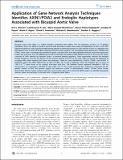Application of Gene Network Analysis Techniques Identifies AXIN1/PDIA2 and Endoglin Haplotypes Associated with Bicuspid Aortic Valve
Author(s)
Wooten, Eric C.; Iyer, Lakshmanan K.; Montefusco, Maria Claudia; Hedgepeth, Alyson Kelley; Payne, Douglas D.; Kapur, Navin K.; Mendelsohn, Michael E.; Huggins, Gordon S.; Housman, David E; ... Show more Show less
DownloadWooten-2010-Application of Gene.pdf (1.167Mb)
PUBLISHER_POLICY
Publisher Policy
Article is made available in accordance with the publisher's policy and may be subject to US copyright law. Please refer to the publisher's site for terms of use.
Terms of use
Metadata
Show full item recordAbstract
Bicuspid Aortic Valve (BAV) is a highly heritable congenital heart defect. The low frequency of BAV (1% of general population) limits our ability to perform genome-wide association studies. We present the application of four a priori SNP selection techniques, reducing the multiple-testing penalty by restricting analysis to SNPs relevant to BAV in a genome-wide SNP dataset from a cohort of 68 BAV probands and 830 control subjects. Two knowledge-based approaches, CANDID and STRING, were used to systematically identify BAV genes, and their SNPs, from the published literature, microarray expression studies and a genome scan. We additionally tested Functionally Interpolating SNPs (fitSNPs) present on the array; the fourth consisted of SNPs selected by Random Forests, a machine learning approach. These approaches reduced the multiple testing penalty by lowering the fraction of the genome probed to 0.19% of the total, while increasing the likelihood of studying SNPs within relevant BAV genes and pathways. Three loci were identified by CANDID, STRING, and fitSNPS. A haplotype within the AXIN1-PDIA2 locus (p-value of 2.926×10[superscript −06]) and a haplotype within the Endoglin gene (p-value of 5.881×10[superscript −04]) were found to be strongly associated with BAV. The Random Forests approach identified a SNP on chromosome 3 in association with BAV (p-value 5.061×10[superscript −06]). The results presented here support an important role for genetic variants in BAV and provide support for additional studies in well-powered cohorts. Further, these studies demonstrate that leveraging existing expression and genomic data in the context of GWAS studies can identify biologically relevant genes and pathways associated with a congenital heart defect.
Date issued
2010-01Department
Massachusetts Institute of Technology. Department of BiologyJournal
PLoS ONE
Publisher
Public Library of Science
Citation
Wooten EC, Iyer LK, Montefusco MC, Hedgepeth AK, Payne DD, et al. (2010) Application of Gene Network Analysis Techniques Identifies AXIN1/PDIA2 and Endoglin Haplotypes Associated with Bicuspid Aortic Valve. PLoS ONE 5(1): e8830. doi:10.1371/journal.pone.0008830
Version: Final published version